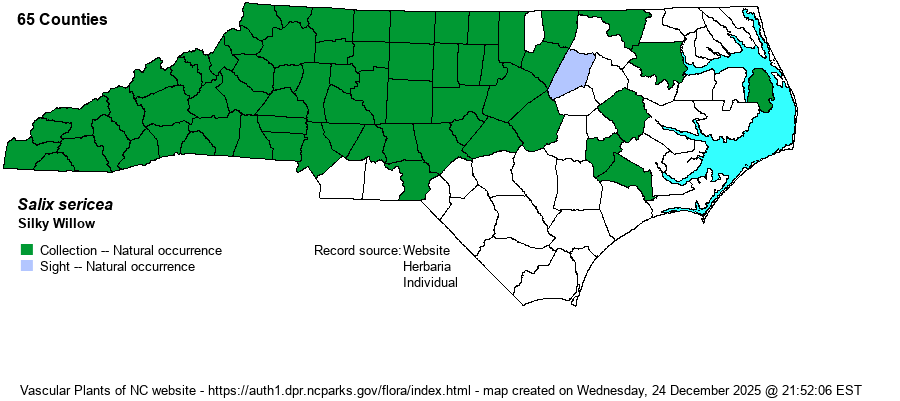| Author | Marshall | |
| Distribution | Throughout the Mountains and Piedmont; also present over some of the northern Coastal Plain. Essentially absent in the southern Coastal Plain (i.e., no records south of Jones, Harnett, and Moore counties). There are remarkably few Piedmont photos on iNaturalist.
This is a somewhat Northern species, ranging from southeastern Canada southward to SC, northern GA, northern AL, and northern AR. It is absent from FL and nearly all of GA.
| |
| Abundance | Though found in essentially every Mountain and Piedmont county (with specimens), it is just fairly common at best in the Mountains; slightly less numerous in the Piedmont, where uncommon to fairly common. Infrequent to uncommon in the northwestern Coastal Plain, and rare east to Bertie and Jones counties, and very rare to Dare County. Typically outnumbered by Black Willow (S. nigra) in most areas where both occur. | |
| Habitat | As with S. nigra and S. caroliniana, this species also occurs in sunny wetlands, but it is less inclined to occur in bottomlands and sandbars as are those tree species. It is found in bogs, seeps, stream banks, ditches, and wet thickets, usually away from taller trees that might shade it out. |
| Phenology | Blooms and fruits in March and April. | |
| Identification | This is a medium-sized, to occasionally large, deciduous shrub, reaching about 10 feet tall. The leaves are narrow but tend to be a bit more elliptic and slightly wider than the narrowly lanceolate leaves of the two tree species. The leaves average about 3 inches long and are characterized by the abundance of silky white hairs on the undersides. Black Willow has rather glabrous and green undersides to the leaves, whereas Coastal Plain Willow leaves are whitened (glaucous) below but are not silky-haired. | |
| Taxonomic Comments | None
The genus Salix is a very large and complex group of plants that vary from ground-hugging Arctic belly plants to huge trees. There are 113 species in North America alone, including introduced species. They are extremely important to browsing mammals -- rabbits, deer, elk, muskox, moose, many rodents -- and browsing birds like ptarmigan. Many birds use them to nest in. Here in NC we only have a small number of native species (5) and so do not appreciate the ecological importance of willows. We highly recommend reading the introductory pages of George Argus's FNA treatment (2010) and his excellent monograph on the willows of the southeastern U.S. (1986). The latter has drawings and descriptions of all southeastern U.S. taxa. Due to natural and horticultural hybridization, some plants will not key cleanly and you may have to compare your specimen with others verified by Argus. | |
| Other Common Name(s) | None | |
| State Rank | S5 | |
| Global Rank | G5 | |
| State Status | | |
| US Status | | |
| USACE-agcp | OBL link |
| USACE-emp | OBL link |

